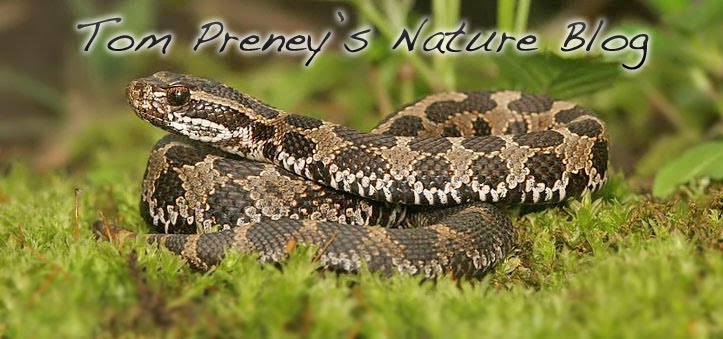In years when the lemming population is scarce, Snowy Owls will often fly south in search of food. However, this year the irruption was attributed to overcrowding on the wintering grounds due to a very successful breeding season. Historic high lemming populations in the Arctic have allowed females to produce up to 12 eggs! For the last three weeks, at least four Snowy Owls have been present outside of Point Pelee National Park. They have been seen regularly in the farm fields on concessions C, D, and E. These birds can be spotted easily as they perch on the ground, and the conspicuous white plumage highly contrasts against the black soil. This has been an exceptional year for Snowy Owls in Southern Ontario with many birds being reported.
Thursday, December 22, 2011
Monday, June 20, 2011
Dragonflies: The Aerial Acrobats
Green Darners are one of the 16 known migratory species of dragonflies. These large dragonflies are the first to arrive from Florida and Southern Texas in early spring. My first record for 2010 was on April 2nd at Ojibway Park in Windsor, Ontario. Very little is known about the dragonfly migration because they fly over such a wide-ranging area, making it difficult to track their movements.
Common Green Darner (Anax junis)
In this photo the female Green Darner is laying eggs in the submerged vegetation. She uses her sharp ovipositor to pierce the stem of the plant and deposit the egg inside.
Dragonflies spend the first stage of their life underwater, feeding on almost anything that moves. The length of the larval stage is species-dependent and could take anywhere from one month to five years to complete their life cycle. When the larva is ready to transform into a dragonfly it will crawl out of the water, attach itself to vegetation, rocks, sand, etc. and then the adult will emerge from the exoskeleton. The exoskeleton or exuviae can be found clinging to the surrounding vegetation. Next time you’re visiting a body of water look closely at the plants near the waters edge for these larval castings, and if you’re really ambitious you can try to identify the dragonfly by keying out the exuviae.
Dragonfly Larva
Damselfly larva can be easily distinguished from dragonfly larva by the three feather-like gills protruding from the abdomen.
At rest, the Spreadwing dragonfly sits with their wings out at an approximate 45-degree angle. This characteristic gives this family of dragonflies its name.
Spotted Spreadwing (Lestes congener)
Damselflies are delicate, narrow-winged dragonflies. When perched they sit with their wings folded back over the abdomen. Damselflies are weak flyers and usually fly low to the ground. These fragile flyers are the smallest of the dragonflies.
Familiar Bluet?
The male attaches himself to the female with his abdominal appendages to ensure his paternity. The pair will fly in tandem until the female has deposited all of her eggs.
The Ebony Jewelwing is the only member of this family to occur in Essex County. These dragonflies are commonly found around flowing water. During the summer, the Cahill Drain at Brunet Park in LaSalle is a reliable place to view these magnificent creatures. Look for their distinctive fluttering flight and bright green iridescent bodies that will be sure to catch your eye.
Ebony Jewelwing (Calopteryx maculata)
Lancet Clubtail (Gomphus exilis)
Clubtails acquired their name from the bulge at the end of their abdomen.
Skimmers are among our most common family of dragonflies. During the summer months these dragonflies can be seen in great numbers on almost any body of water.
Twelve-spotted Skimmer (Libellula pulchella)
Carolina Saddlebags (Tramea carolina)
Black Saddlebags (Tramea lacerata)
Calico Pennant (Celithemis elisa)
Dot-tailed Whiteface (Leucorrhinia intacta)
Dot-tailed Whiteface (female)
Eastern Amberwing (Perithemis tenera)
Blue Dasher (Pachydiplax longipennis)
Blue Dasher (Female)
Ruby Meadowhawk (Sympetrum obtrusum)
Immature Male
Female
White-faced Meadowhawk (Sympetrum rubicundulum)
A total of 169 species of damselflies and dragonflies have been recorded in Ontario.
Labels:
amberwing,
clubtail,
damselfly,
darner,
dragonfly,
exoskeleton,
exuviae,
jewelwing,
larva,
meadowhawk,
saddlebags,
skimmer,
spreadwing
Friday, May 20, 2011
Migration: A Journey Against the Elements
After their long flight over Lake Erie, songbirds burn up most of their fat reserves and depend on Point Pelee to fuel up for their next flight. Unfortunately the weather this past week has been unseasonably cool with lots of rain, and this combination makes it very difficult for them to find food (insects). The majority of the birds I encountered today were below eye-level, foraging in the undergrowth, and when I made it to the "tip" warblers were perched on the sand, completely exhausted. It was very hard to watch them as they struggled to find food after making it all this way, and because Mother Nature wasn't cooperating, these birds would probably perish. I couldn't help but wonder what these birds had already been through on this journey we call migration; it really is an amazing feat.
Black-throated Green Warbler
Chestnut-sided Warbler
Red-eyed Vireo
Magnolia Warbler
This Eastern Pipistrelle was hanging outside of the women's washroom down at the tip; looking a little chilly.
Even the interior of the park was filled with hungry songbirds. It made for amazing viewing and photo opportunities.
Scarlet Tanager (male)
Scarlet Tanager (Female)
Prothonotary Warbler
Eastern Wood-Pewee
Black-throated Green Warbler
Wilson's Warbler
Lincoln's Sparrow
Note the black-legged tick on the eyering.
American Redstart
Monday, January 17, 2011
Royal Botanical Gardens
The Royal Botanical Gardens choose two of my photographs for their new interpretive signs, cool!
The two photographs were taken at the Ojibway Prairie Provincial Nature Reserve
Tallgrass Prairie and Oak Savannah are two of the most endangered ecosystems in Ontario. I'm a firm believer that outreach and education is one of the most important things we can do to help. So I am honored to have my photographs on the signs.
Click on the photos below to enlarge the picture, take two seconds and read them, you might learn a thing or two :)
Subscribe to:
Comments (Atom)




















































